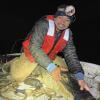Hi all,
I am no expert in the underlying machine learning models, algorithms, and AI-things used to identify animals in the various computer-vision tools out there (MegaDetector, Wildlife Insights, Deep Faune, etc), so please excuse my possibly uninformed question and my likely incorrect use of jargon (or knowledge of the matter).
I've gotten to use several of computer-vision tools over the years and I've found that, in most cases, they fail to locate/identify small animals when those animals don't really "contrast" with the background, when a photo is blurred by fog, or when only parts of an animal is visible (I work with a burrow-nesting seabird that nests in fog-prone Caribbean mountains). I am usually (at least, more often than computer vision models) able to see those animals because I can look at several images in a flipbook way: "flipping" through them fast enough so I can detect the changes in photos, either in forward or back-and-forth between two images.
I always wondered how much of this "flipbook", sequence-based approach is implemented in computer-vision. I'm guessing it is but it's difficult for a non-expert to understand all the underlying machinery of computer-vision.
Also, could an approach like "motion extraction" used in videos (https://www.thisiscolossal.com/2024/01/motion-extraction/) be useful to analyze sequences of still images - if not already implemented?
16 January 2024 4:21pm
Hi Yvan,
Very good point!
I have similar experience as you - but with another species (arctic fox).
I am pretty sure this came up in one of the various webinars (recorded) on camera trapping and AI - I cannot remember which one though. I will see if I can find it on the Wildlabs youtube.
There are a lot of candidates ... :
WILDLABS.NET - YouTube
WILDLABS is the first global, open online community dedicated to conservation technology. Together, we share information, ideas, tools and resources to disco...
I seem to remember that differencing methods or even methods making use of sequences were said to be underexplored.
The image database and tagging software Timelapse does have a image differencing mode which can support detecting hard to see animals.
Best regards,
Lars

Herdhanu Jayanto
KONKLUSI (Kolaborasi Inklusi Konservasi - Yayasan)
16 January 2024 4:24pm
Hi Yvan!
Have use consider using EcoAssist from @pvlun? It is end-user UI software that use MegaDetectorv5. It is very user friendly. I just used it since last month and very helpful and neat for non coder like me. It helps us to label animal detection and non-detection, and include human verification process and works both for still images and video. It can also give you output for timelapse. I haven't figured out how to use species identification model, but looking forward to figure it out later.
Hope this helps! Cheers,
Dhanu
AddaxAI - Simplifying camera trap image analysis with AI
Previously known as EcoAssist. An AI platform to analyse images with machine learning models for automatic detection, so that ecologists can save time and focus on conservation efforts.










Lars Holst Hansen
Aarhus University